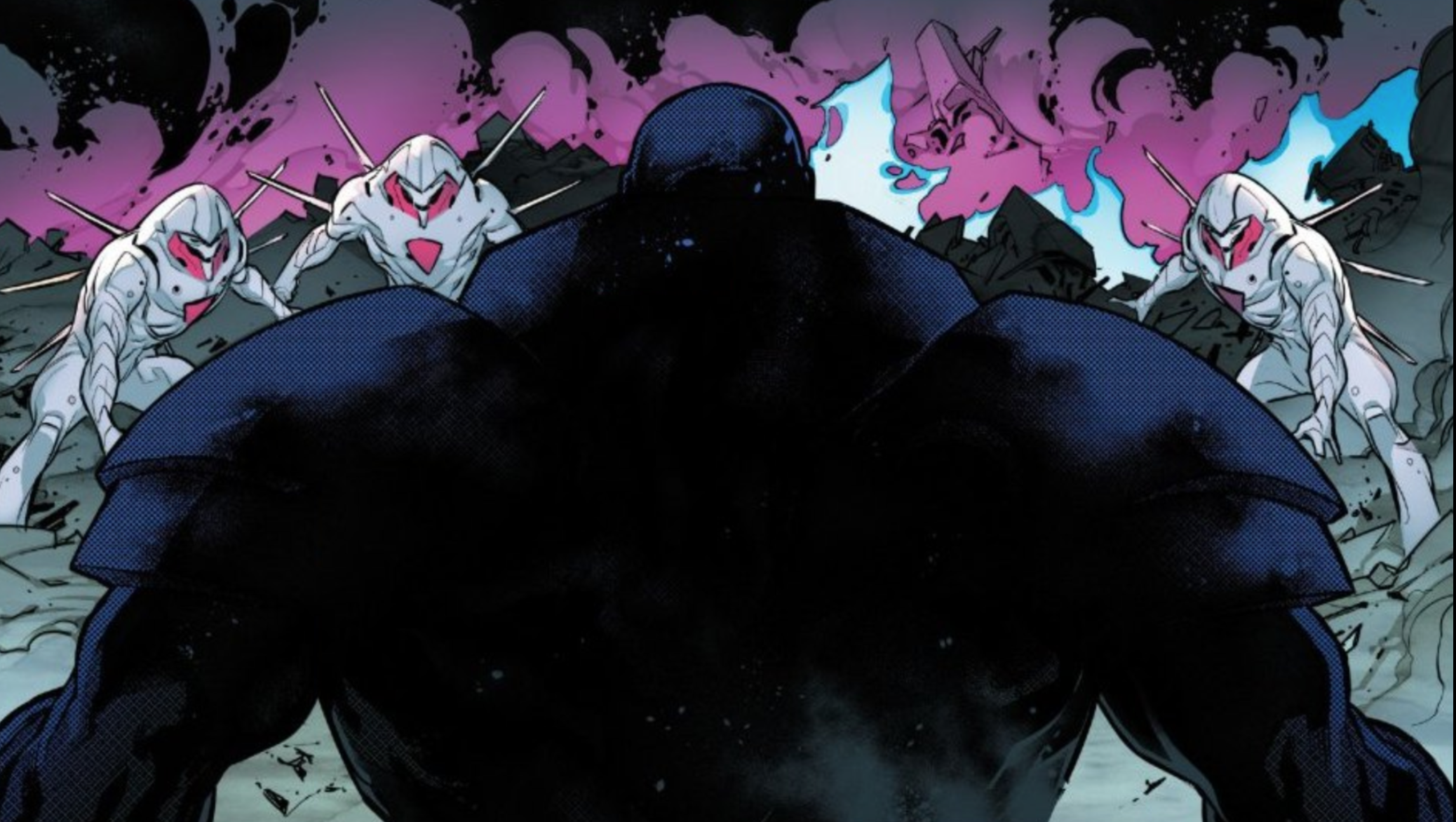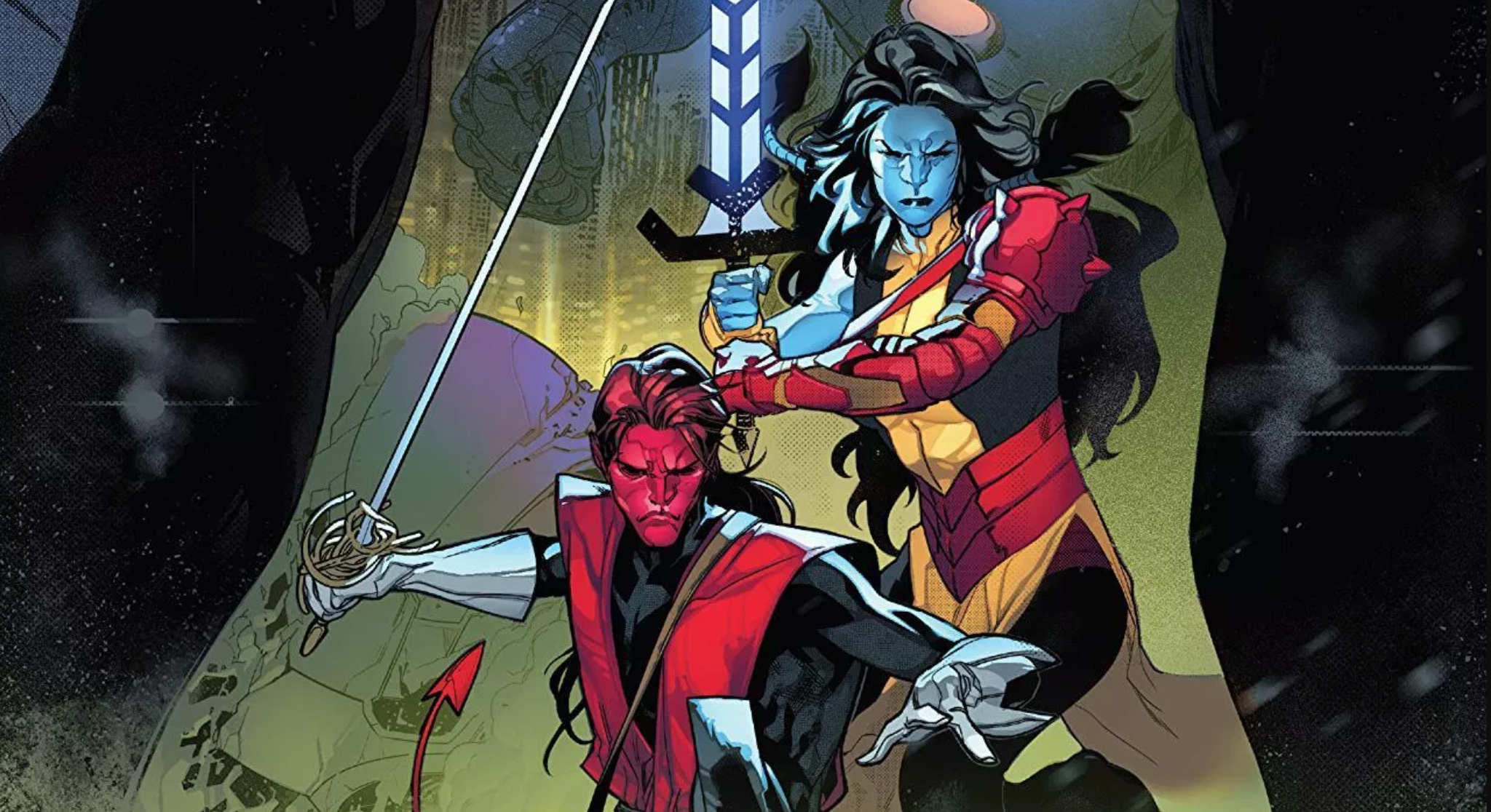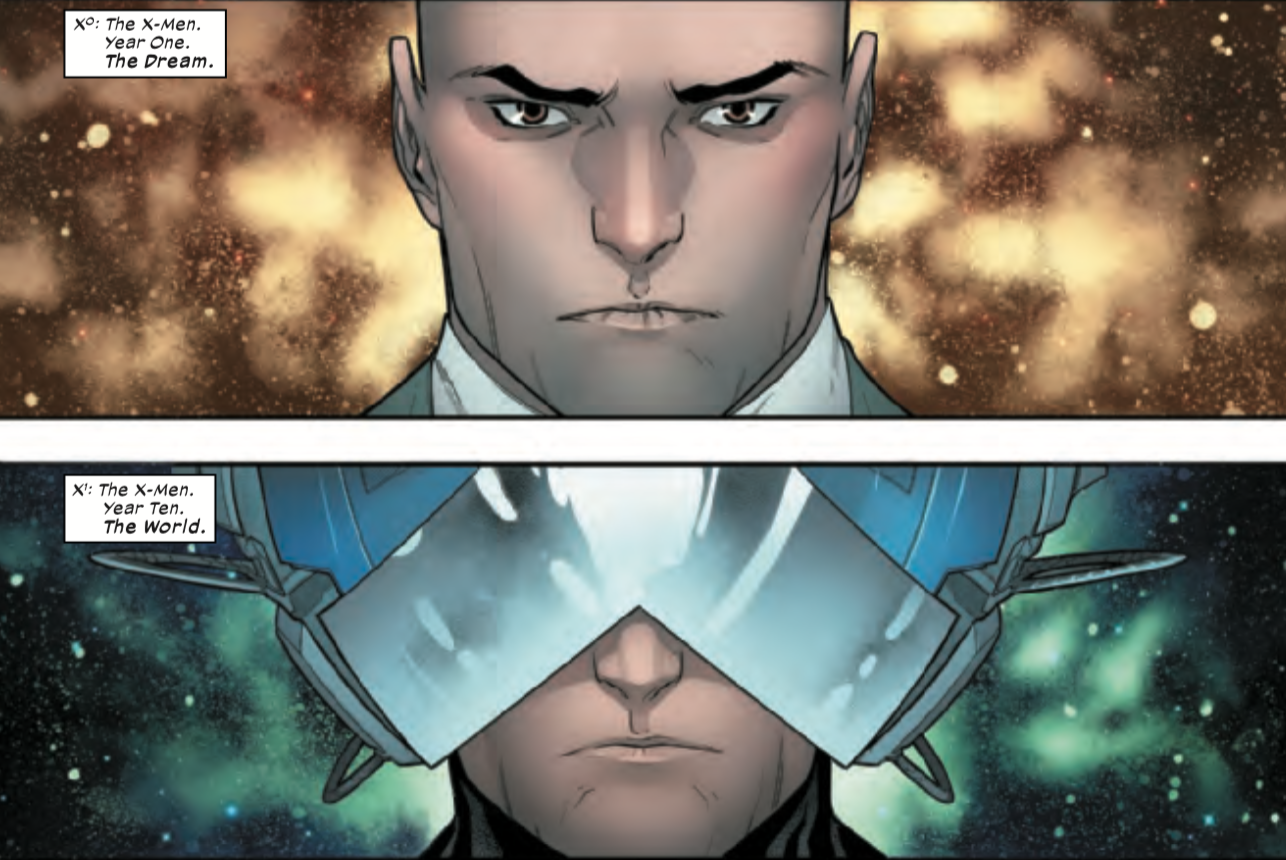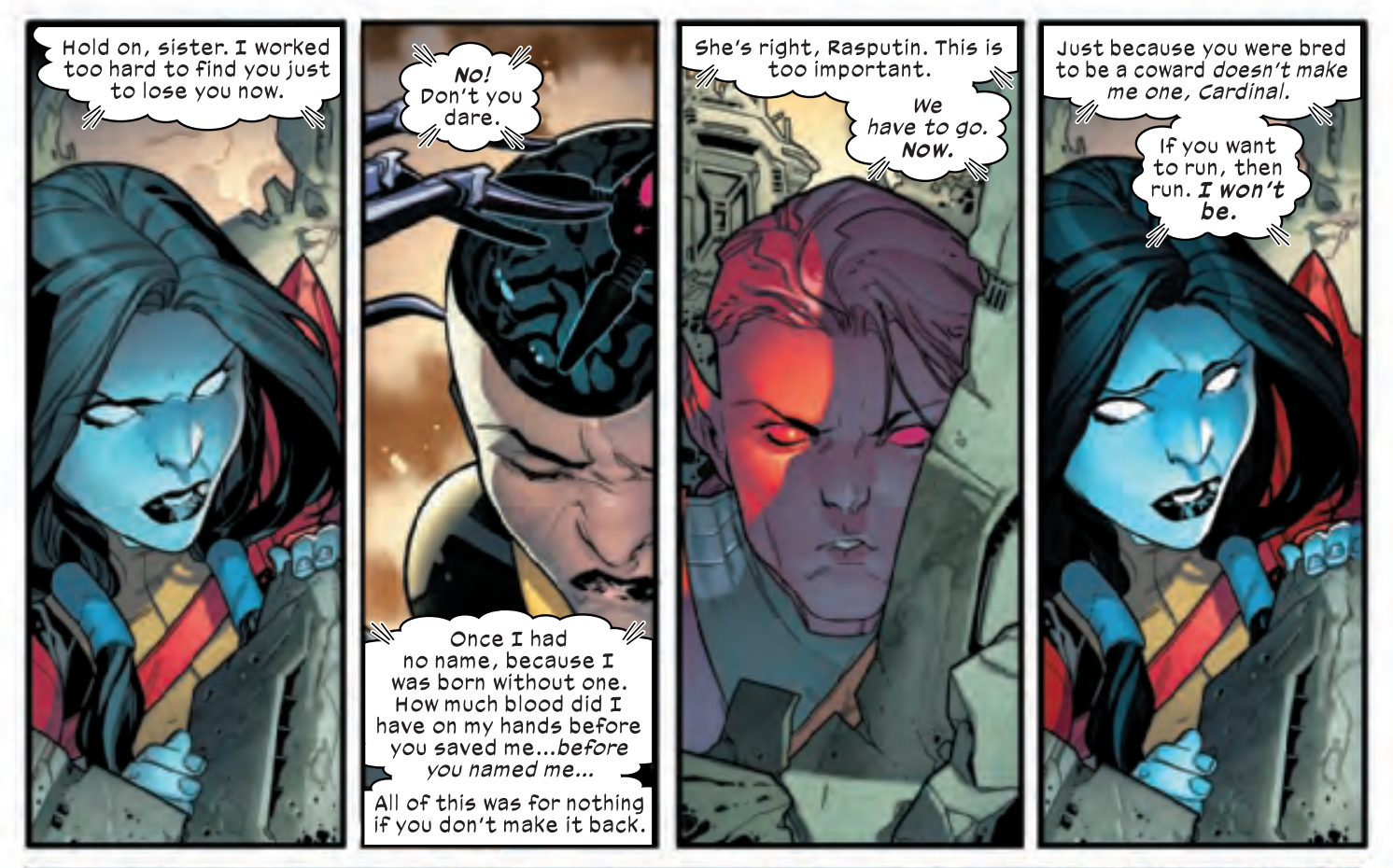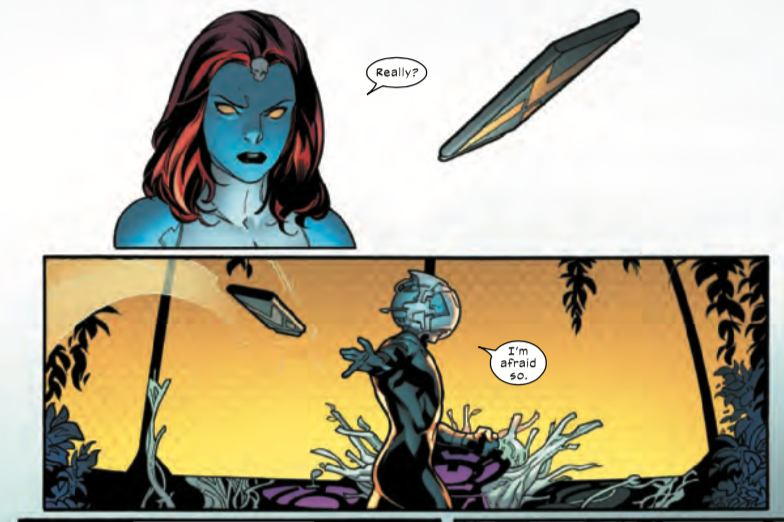House of X
“House of X”
Powers of X #6 (2019)
Written by Jonathan Hickman
Art by R.B. Silva with Pepe Larraz
Color art by Marte Gracia and David Curiel
Powers of X #6 is the end of the beginning; the final notes of the overture to what is promised to be Jonathan Hickman’s grand mutant opera. Now that the full shape of House of X/Powers of X is known, we can see that this was very much the origin story of the Krakoan nation, and how this bold new plan for a unified mutant front was devised with the knowledge of Moira MacTaggert’s nine previous lives. It’s so simple when put that way!
This issue is focused on Moira, and its primary action is centered in the far future timeline of the ascension, which we now know to be the end of Moira’s previously unknown sixth life. It’s not quite clear how Moira is alive this far into the future, much less fairly young looking, but she’s there in the preserve that was introduced in the first issue of POX along with the Wolverine of this timeline. They’re the captive of the Librarian who set up the ascension plan with the Phalanx, who turns out to be homo novissima, the end-stage hyper-evolved product of centuries of genetic engineering. The machines, the Nimrods, all of this extermination of mutantdom? All just a diversionary tactic to keep mutants from interfering with the process of breeding something far beyond human or mutant.
Wolverine kills the Librarian after Moira extracts everything she needs to know to carry over to her next life. And then her next three lives after that. It’s unclear how she ended up on the path that brought her and Wolverine to the Librarian’s preserve – a story for another day, I hope – but it’s now much more understandable how her 7th, 8th, and 9th lives were so angry and desperate. This leaves the Moira of this timeline, our timeline and the one she believes to be her last life, in a position of desperation and some degree of repentance for having been involved in so many awful things. The House of X has to work.
The centerpiece of the issue is a set of Moira’s diary entries that fill in lot of details about how the House of X plan came together with Charles Xavier and Magneto, and explain how this retcon fits into previous X-Men continuity. There’s some very casual bombshells dropped in these pages – for example, the revelation that Moira and Xavier both became the parents of reality-warping mutants (Proteus and Legion, respectively) because they knew they would need someone with that power to enable the mutant resurrection protocol and deliberately found mates who would produce this sort of offspring in combination with their own mutant genes. I actually gasped upon reading that bit.
We learn a lot about how necessary it was for Moira to break Xavier’s inherent optimism and idealism, and how difficult it was for her to deal with the “casual arrogance” of Magneto. She notes that Sinister has turned himself into a chimera mutant, decades ahead of schedule compared to the other timelines. There’s also some oblique explanation for how the plot of the Magneto/Moira storyline in X-Men #1-3 by Chris Claremont and Jim Lee – the best-selling comic book story of all time! – fits into all of this.
The story ends with Xavier, Magneto, and Moira meeting after the Krakoan nation has been established, and the Quiet Council is nearly complete. Moira is in hiding, as she’s been for many years. It would seem that the only people aware of her being alive or her role in this grand plan are Xavier and Magneto.
Moira seems very paranoid in her isolation, and is deeply afraid of the notion of Destiny being revived to placate Mystique, or of precognitive mutants in general because she fears what would happen if the other mutants discovered that mutantdom is snuffed out in every iteration of her life. This makes some sense given that she has up to 2000 years of regrets and anxieties to live with, but it also seems like a deep-seated fear of Destiny in particular after her ordering her agonizing death at the end of life three. And what does she actually fear Destiny telling the other mutants – that mutantdom is doomed every time, which many probably would believe anyway given everything they’ve personally experienced, or that in her third life she tried to wipe out mutants herself?
Hickman ends HOX/POX on a high note, but undercuts the sense of triumph with Moira’s nagging doubt. What if this is still not enough? What if the mutants resist this attempt at species-wide unity? What if mutants really are doomed, just as they’ve been in all of Moira’s previous lives, and most every other future and alternate timeline in the history of the franchise? These are the stakes going forward, and they’ve never been higher.
So now we look ahead to the new X-Men series by Hickman, which begins next week. Hickman has planted seeds for major stories with most of the X-Men’s major antagonists:
• Orchis will certainly seek retaliation for the destruction of the Mother Mold, and will be an ongoing threat for sure.
• Nimrod will inevitably be created at some point in his run, and we’ll probably see the beginnings of the genetic engineering that will eventually lead to homo novissama.
• Apocalypse will begin a quest to find his original Horsemen on Arrako, the lost twin of Krakoa.
• We’ll need to explore the mystery of what Mister Sinister has done to take advantage of the genetic archive, and how he may have sabotaged or corrupted the resurrection protocol.
• “Inferno 2,” anyone?
• It’s only a matter of time before Destiny is resurrected, and we’ll get to see whether Moira’s fears are valid. How will all the mutants of Krakoa respond to learning about Moira and her many lives? I suspect that the deeply nihilistic Mystique will be not be pleased, and this will set her up to go rogue.
• Sabretooth’s breakout from imprisonment and pursuit of vengeance. Perhaps he is recruited by Mystique? We’ll see. I’d be more excited for him to just claw his way back up to the surface and go on a rampage at the worst possible time…like, say, after the resurrection protocol is inevitably broken.
• We’ll certainly see the Phalanx again, but I wonder if the notion that the worlds Moira inhabits in each of her lives dies with her is just a bluff. It doesn’t make much sense, and Hickman has put way too many pages into establishing the notion of the Phalanx absorbing the offering of the mutant consciousness archive to just never show us what happens. The Librarian makes a point of stating that once the Phalanx merges into a Dominion it will exist outside of time and space, and I believe that is the path to this popping up in the main timeline down the road. Also, it seems very likely that the Moira 6 version of Wolverine will be merged with the Phalanx, and the Librarian mentions this as a possibility in passing. Given the layers of abstraction in the Phalanx/Dominion concept, it would be narratively useful to give it a familiar face in the form of the franchise’s most popular character.
• It can’t be too long before things with the Hellfire Club go wrong, and I suspect the long term arc of Hickman’s run will bend towards Magneto doing something horrible and breaking off from Xavier. I think he’s setting the readers up for a heartbreak right now.
Some lingering questions:
• How exactly is Moira alive in the far future of life six? There’s a line about her having the same blood type as Wolverine, but that only barely makes sense. If that’s the hand wave explanation, then OK, sure, but it’s awfully flimsy.
• I’m not quite sure why this issue, HOX #2, and HOX #5 were color coded as red. This and HOX #2 are both Moira issues, but she’s not in HOX #5 at all. I suppose they are all big reveal issues, but in that case, wouldn’t POX #3 with its Moira 9 reveal also be one of those?
• How were the full capabilities of Krakoa discovered? Moira clearly learned about this from Apocalypse in life nine, but when did she and Xavier begin work on this in life ten? And how does this relate to the formation of the second class of X-Men in the original Krakoa story back in Giant Size X-Men #1?
• What will Moira do with what she learned from the Librarian in life six? Is the X-Men’s longtime association with the Shi’ar actually about Xavier courting a galactic society as a form of ascension? Or is that more about forming the alliances that led mutants to end up in Shi’ar systems in her ninth life?
• Surely there’s a good number of mutants who aren’t totally into the Krakoan mutant society thing, right? We don’t see any dissent among the ranks in this story, but I have to assume this will be part of the narrative in Hickman’s X-Men and the assorted spin-off series going forward.













